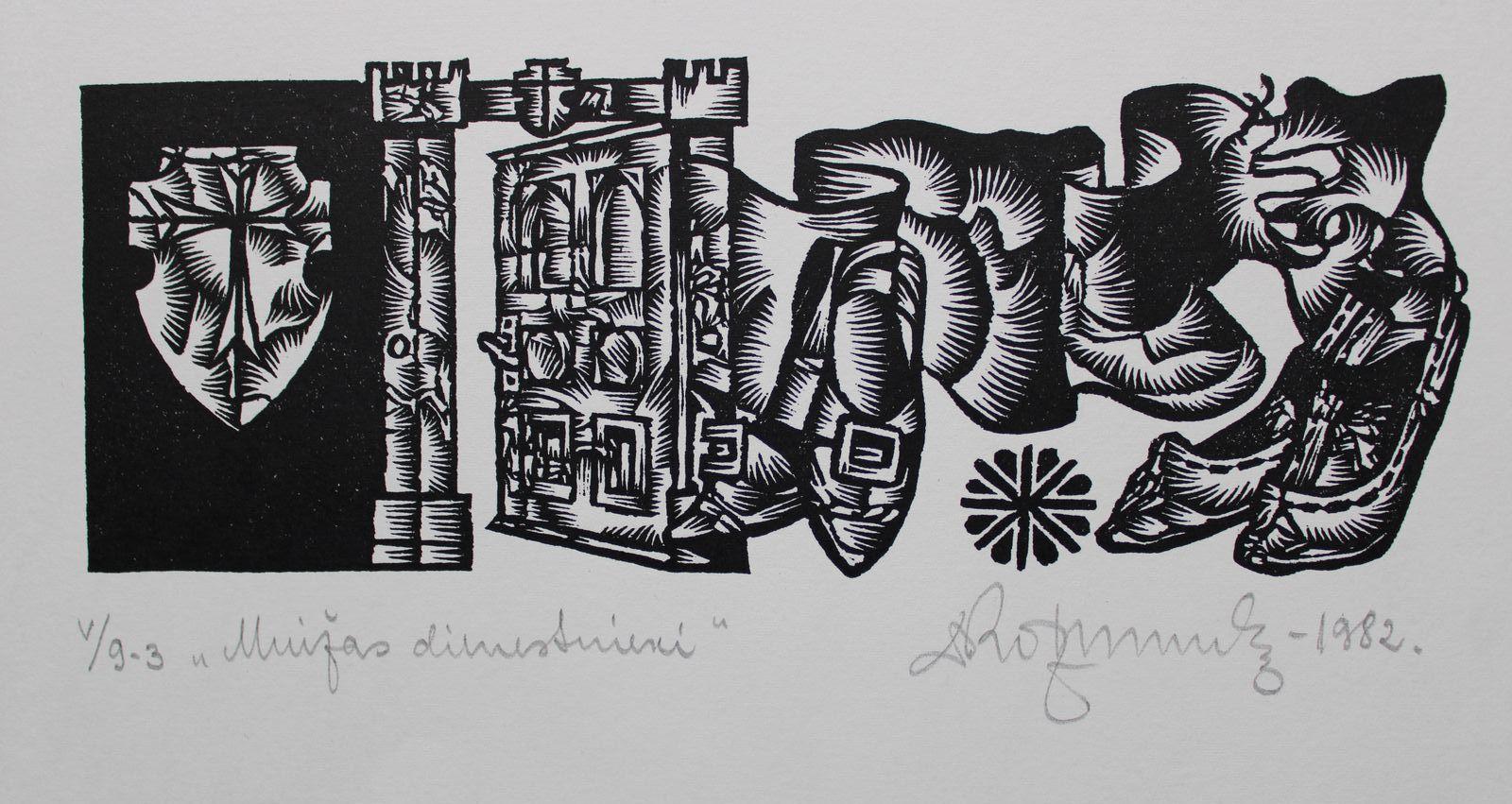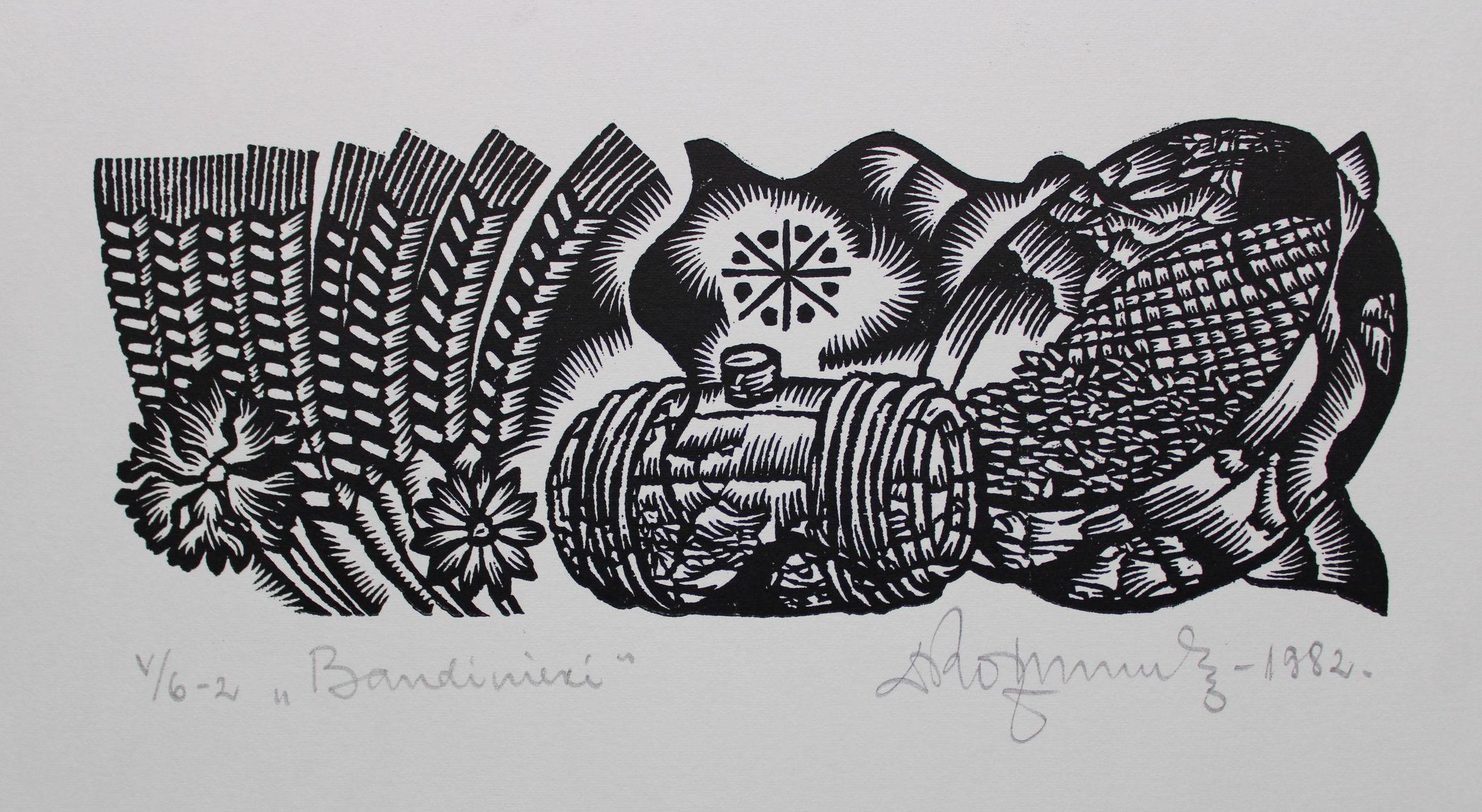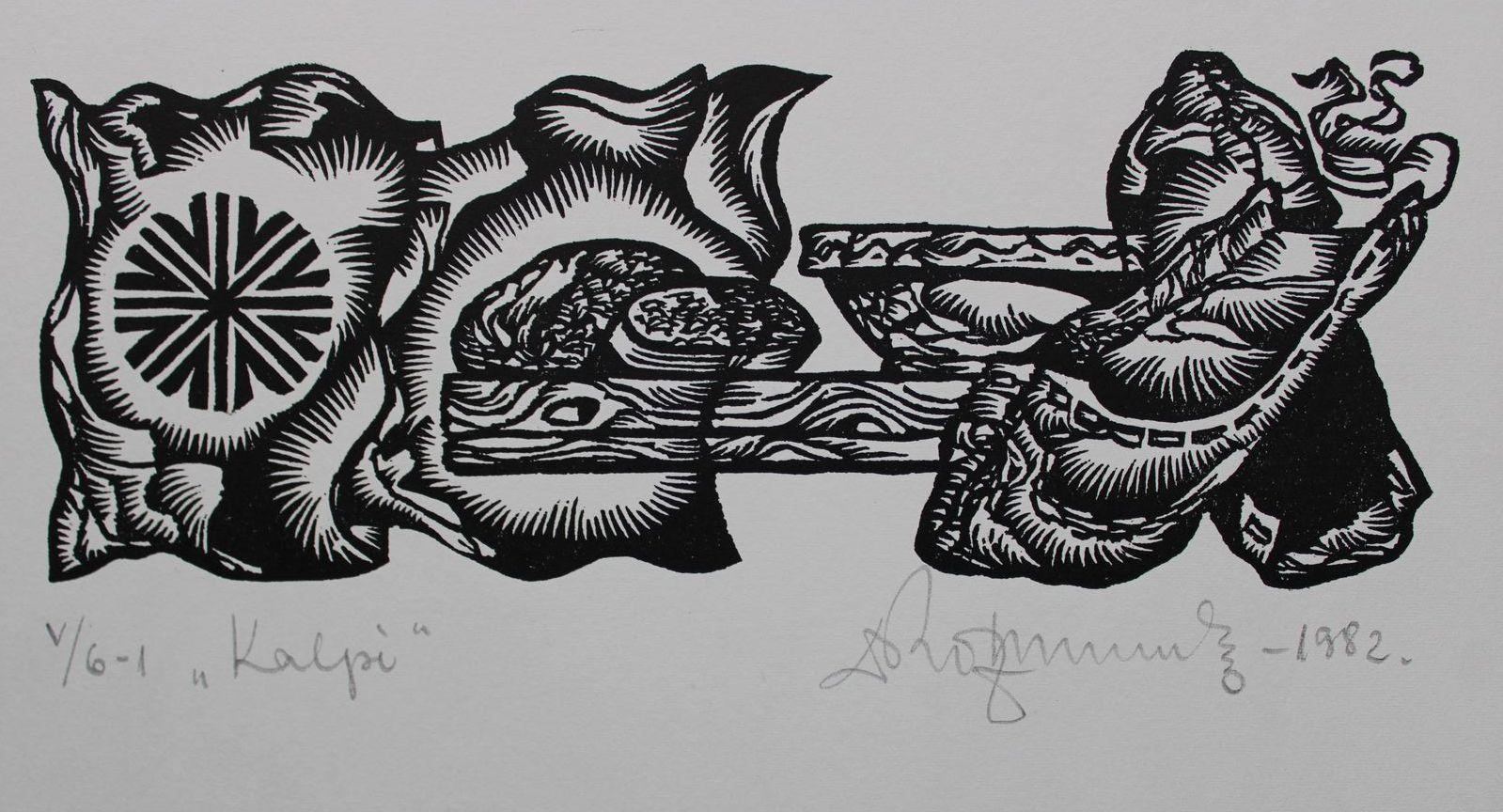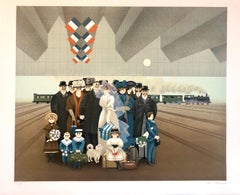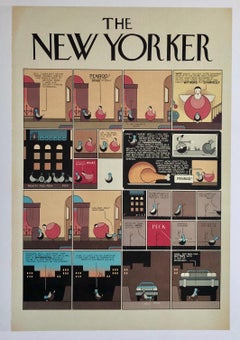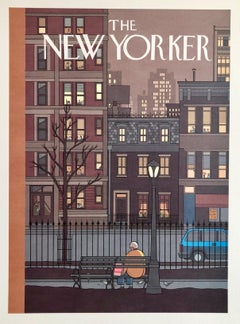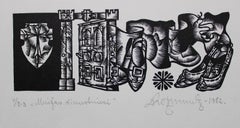
Der Maler (The Artist)
View Similar Items
Want more images or videos?
Request additional images or videos from the seller
1 of 8
Hajo MalekDer Maler (The Artist)1983
1983
About the Item
- Creator:Hajo Malek (1922 - 2000, German)
- Creation Year:1983
- Dimensions:Height: 24.5 in (62.23 cm)Width: 17.75 in (45.09 cm)
- More Editions & Sizes:20.4 x 14 There is some damage on the frame in the top left corner.Price: $100
- Movement & Style:
- Condition:there is some wear to the matting can be rematted. please see photos.
- Gallery Location:Surfside, FL
- Reference Number:1stDibs: LU382116524
About the Seller
4.9
Platinum Seller
These expertly vetted sellers are 1stDibs' most experienced sellers and are rated highest by our customers.
Established in 1995
1stDibs seller since 2014
1,550 sales on 1stDibs
Typical response time: 1 hour
More From This SellerView All
- Naive Lithograph Paris Train Station Wedding Party, Honeymoon Scene Folk ArtLocated in Surfside, FLHand signed, limited edition on BFK Rives French art paper. I believe the title is Honeymoon. Jan Balet (20 July 1913 in Bremen – 31 January 2009 in Estavayer le Lac, Switzerland), was a German/US-American painter, graphic artist and illustrator. Affected by the folk art style of naive art he worked particularly as a graphic artist and as an Illustrator of children's books. His works exhibit a dry wit and refreshingly candid, whimsical, satirical view of life. His uncle was the famous painter and illustrator Benno Eggert. Many well-known personalities of the time were friends of his grandfather, i.e. the painters Hans Purrmann, Karl Caspar, Maria Caspar-Filser (cousin of his mother), the writer Martin Andersen Nexo, the Swabian poet Wilhelm Schussen as well as the poet and writer Oskar Wöhrle. In 1929, at the age of 17, he moved to Berlin at the invitation of his father and studied Drawing at the college of Arts and Crafts (Kunstgewerbeschule Ost am Schlesischen Bahnhof). A year later, he went to live with his mother and his grandmother, in Munich. Balet transferred his studies to the Munich College of Arts but was dismissed in 1932. He went on to study with Professor Ege, at a private school for commercial art. During this time he also worked at an institute for lithography and for the art gallery Wallach. Balet rented his first small studio at the age of nineteen, where he manufactured and sold hand colored Bavarian woodcuts. 1934 he passed the entrance examination to the Akademie der Bildenden Künste München and undertook further studies with Olaf Gulbransson. His work is of a popular style similar to Michel Delacroix, Charles Fazzino and James Rizzi. In early 1938 Balet was recruited by the German military and because his ancestor's passport was not complete, he was forbidden to associate further with the Akademie der Bildenden Künste München. Later that year Balet emigrated to the USA, settled in New York and painted rustic furniture for a living. One winter he jobbed as a skiing teacher in Vermont and occasionally jobbed as an advertising commercial artist. Among other projects, he painted the cafeteria of the largest of New York's department stores R.H. Macy. From time to time Balet's designs appeared in the fashion magazine Mademoiselle and in 1943 he became Art Director at the magazine. Balet became so successful as a commercial artist that he was able to give up paid employment and start his own business. He worked for the radio station CBS, magazines such as Vogue, House and Garden, House Beautiful, The Saturday Evening Post, Glamour, Good Housekeeping, This week. After the war ended in 1945 he acquired U.S. citizenship. Balet commuted between his studio in New York and an old, boat house in the dunes of Montauk, Long Island, which he had converted to a studio where he painted and drew. His first children's book Amos and the Moon was published in 1948. Despite what was regarded in the USA as fashionable art Abstract, Op-art and Pop Art, Balet continued to paint in his own naif style. Art work (Children books and sketchbooks) 1948 Amos and the moon, Henry Z. Walck Verlag New York 1949 Ned, Ed and the lion 1951 What makes an orchestra 1959 The five Rollatinis, J. B. Lippincott Co. Verlag New York 1965 Joanjo, Pharos Verlag Basel 1966 Das Geschenk Eine portugiesische Weihnachtsgeschichte, Betz-Verlag München 1967 Der König und der Besenbinder, Betz-Verlag München 1969 Der Zaun, Otto Maier Verlag München 1969 Ladismaus, Betz-Verlag München 1979 Ein Skizzenbuch, Windecker Winkelpresse 1980 Katzen-Skizzen, Windecker Winkelpresse 1981 Skizzen-Paare, Windecker Winkelpresse 1981 Die Leihkatze oder Wie man Katzen lieben lernt, Windecker Winkelpresse (Author: Otto Schönberger) 1982 Paris-Skizzen, Windecker Winkelpresse 1984 Hellas-Skizzen, Windecker Winkelpresse 1993 Wasser-Skizzen, Edition Toni Pongratz 1994 Die Zeppeline des Jan Balet, Zeppelin-Museum Friedrichshafen (Taschenbuch) 2008 Angekommen: Gedichte (Author: Hans Skupy) Publicationen, which Jan Balet illustrated 1945 Alarcon, P.A.: Tales from the Spanish, Allentown 1948 Hanle-Zack, D.: The golden ladle, Chicago-New York 1952 Wing, H.: Rosalinda, Chicago 1953 Wing, H.: The lazy lion...Category
20th Century Folk Art Figurative Prints
MaterialsLithograph
- Chris Ware New Yorker Cartoonist Limited Edition Thanksgiving Print NYCBy Chris WareLocated in Surfside, FLThis is one print – printed in full color on 15" x 20" heavy cream-colored paper. It is from a limited edition series of 175, the portfolio is hand numbered and hand signed by Chris Ware. the individual prints are not. The page with the hand signature is included here as a photo for reference only it is not included in this sale. Franklin Christenson "Chris" Ware (born December 28, 1967), is an American cartoonist known for his Acme Novelty Library series (begun 1994) and the graphic novel Jimmy Corrigan, the Smartest Kid on Earth (2000) and Building Stories (2012). His works explore themes of social isolation, emotional torment and depression. He tends to use a vivid color palette and realistic, meticulous detail. His lettering and images are often elaborate and sometimes evoke the ragtime era or another early 20th-century American design style. Ware often refers to himself in the publicity for his work in self-effacing, even withering tones. He is considered by some critics and fellow notable illustrators and writers, such as Dave Eggers, to be among the best currently working in the medium; Canadian graphic-novelist Seth has said, "Chris really changed the playing field. After him, a lot of [cartoonists] really started to scramble and go, 'Holy [expletive], I think I have to try harder.'" While still a sophomore at UT, Ware came to the attention of Art Spiegelman, who invited Ware to contribute to Raw, the influential anthology magazine Spiegelman was co-editing with Françoise Mouly. Ware has acknowledged that being included in Raw gave him confidence and inspired him to explore printing techniques and self-publishing. His Fantagraphics series Acme Novelty Library defied comics publishing conventions with every issue. Ware's art reflects early 20th-century American styles of cartooning and graphic design, shifting through formats from traditional comic panels to faux advertisements and cut-out toys. Stylistic influences include advertising graphics from that same era; newspaper strip cartoonists Winsor McCay (Little Nemo in Slumberland) and Frank King (Gasoline Alley); Charles Schulz's post-WWII strip Peanuts and the cover designs of ragtime-era sheet music. Ware has spoken about finding inspiration in the work of artist Joseph Cornell and cites Richard McGuire's strip Here as a major influence on his use of non-linear narratives. He is one of the great practitioners who have elevated the graphic novel style along with, Shepard Fairey, Ben Katchor and Robert Crumb. Quimby the Mouse was an early character for Ware and something of a breakthrough. Rendered in the style of an early animation character like Felix the Cat, Quimby the Mouse is perhaps Ware's most autobiographical character. Ware's Building Stories was serialized in a host of different venues. It first appeared as a monthly strip in Nest Magazine. Installments later appeared in a number of publications, including The New Yorker, Kramer's Ergot, and most notably, the Sunday New York Times Magazine. Building Stories appeared weekly in the New York Times Magazine from September 18, 2005 until April 16, 2006. A full chapter was published in Acme Novelty Library, number 18. Another installment was published under the title "Touch Sensitive" as a digital app released through McSweeneys. The entire narrative was published as a boxed set of books by Pantheon in October 2012. Ware was commissioned by Chip Kidd to design the inner machinations of the bird on the cover of Haruki Murakami's novel The Wind-Up Bird Chronicle. In 2011, Ware created the poster for the U.S. release of the 2010 Palme d'Or winning film Uncle Boonmee Who Can Recall His Past Lives by Thai director Apichatpong Weerasethakul. Awards and honors Over the years his work garnered several awards, including the 1999 National Cartoonists Society's Award for Best Comic Book for Acme Novelty Library and Award for Graphic Novel for Building Stories. Ware has won numerous Eisner Awards and multiple Harvey Awards. In 2002, Ware became the first comics artist to be invited to exhibit at Whitney Museum of American Art biennial exhibition. With Will Eisner, Jack Kirby, Harvey Kurtzman, Robert Crumb and Gary Panter, Ware was among the artists honored in the exhibition "Masters of American Comics" at the Jewish Museum in New York City, New York, from September 16, 2006 to January 28, 2007. His work was the subject of solo exhibitions at the Museum of Contemporary Art, Chicago in 2006 and at the University of Nebraska's Sheldon Museum of Art, in 2007. Many famous artists have done covers for the New Yorker Magazine including, Saul Steinberg, Maira Kalman, Art Spiegelman, Francoise Mouly, Charles Addams, Peter Arno, Roz Chast, Ed Koren...Category
Early 2000s American Modern Figurative Prints
MaterialsColor
- Chris Ware New Yorker Cartoonist Limited Edition Thanksgiving Print NYCBy Chris WareLocated in Surfside, FLThis is one print – printed in full color on 15" x 20" heavy cream-colored paper. It is from a limited edition series of 175, the portfolio is hand numbered and hand signed by Chris Ware. the individual prints are not. The page with the hand signature is included here as a photo for reference only it is not included in this sale. Franklin Christenson "Chris" Ware (born December 28, 1967), is an American cartoonist known for his Acme Novelty Library series (begun 1994) and the graphic novel Jimmy Corrigan, the Smartest Kid on Earth (2000) and Building Stories (2012). His works explore themes of social isolation, emotional torment and depression. He tends to use a vivid color palette and realistic, meticulous detail. His lettering and images are often elaborate and sometimes evoke the ragtime era or another early 20th-century American design style. Ware often refers to himself in the publicity for his work in self-effacing, even withering tones. He is considered by some critics and fellow notable illustrators and writers, such as Dave Eggers, to be among the best currently working in the medium; Canadian graphic-novelist Seth has said, "Chris really changed the playing field. After him, a lot of [cartoonists] really started to scramble and go, 'Holy [expletive], I think I have to try harder.'" While still a sophomore at UT, Ware came to the attention of Art Spiegelman, who invited Ware to contribute to Raw, the influential anthology magazine Spiegelman was co-editing with Françoise Mouly. Ware has acknowledged that being included in Raw gave him confidence and inspired him to explore printing techniques and self-publishing. His Fantagraphics series Acme Novelty Library defied comics publishing conventions with every issue. Ware's art reflects early 20th-century American styles of cartooning and graphic design, shifting through formats from traditional comic panels to faux advertisements and cut-out toys. Stylistic influences include advertising graphics from that same era; newspaper strip cartoonists Winsor McCay (Little Nemo in Slumberland) and Frank King (Gasoline Alley); Charles Schulz's post-WWII strip Peanuts and the cover designs of ragtime-era sheet music. Ware has spoken about finding inspiration in the work of artist Joseph Cornell and cites Richard McGuire's strip Here as a major influence on his use of non-linear narratives. He is one of the great practitioners who have elevated the graphic novel style along with, Shepard Fairey, Ben Katchor and Robert Crumb. Quimby the Mouse was an early character for Ware and something of a breakthrough. Rendered in the style of an early animation character like Felix the Cat, Quimby the Mouse is perhaps Ware's most autobiographical character. Ware's Building Stories was serialized in a host of different venues. It first appeared as a monthly strip in Nest Magazine. Installments later appeared in a number of publications, including The New Yorker, Kramer's Ergot, and most notably, the Sunday New York Times Magazine. Building Stories appeared weekly in the New York Times Magazine from September 18, 2005 until April 16, 2006. A full chapter was published in Acme Novelty Library, number 18. Another installment was published under the title "Touch Sensitive" as a digital app released through McSweeneys. The entire narrative was published as a boxed set of books by Pantheon in October 2012. Ware was commissioned by Chip Kidd to design the inner machinations of the bird on the cover of Haruki Murakami's novel The Wind-Up Bird Chronicle. In 2011, Ware created the poster for the U.S. release of the 2010 Palme d'Or winning film Uncle Boonmee Who Can Recall His Past Lives by Thai director Apichatpong Weerasethakul. Awards and honors Over the years his work garnered several awards, including the 1999 National Cartoonists Society's Award for Best Comic Book for Acme Novelty Library and Award for Graphic Novel for Building Stories. Ware has won numerous Eisner Awards and multiple Harvey Awards. In 2002, Ware became the first comics artist to be invited to exhibit at Whitney Museum of American Art biennial exhibition. With Will Eisner, Jack Kirby, Harvey Kurtzman, Robert Crumb and Gary Panter, Ware was among the artists honored in the exhibition "Masters of American Comics" at the Jewish Museum in New York City, New York, from September 16, 2006 to January 28, 2007. His work was the subject of solo exhibitions at the Museum of Contemporary Art, Chicago in 2006 and at the University of Nebraska's Sheldon Museum of Art, in 2007. Many famous artists have done covers for the New Yorker Magazine including, Saul Steinberg, Maira Kalman, Art Spiegelman, Francoise Mouly, Charles Addams, Peter Arno, Roz Chast, Ed Koren...Category
Early 2000s American Modern Figurative Prints
MaterialsColor
- Girl in Ballerina Dress (Thonet Chair) Color Lithograph, American ModernistBy Philip PearlsteinLocated in Surfside, FLGirl in Ballerina Dress, c. 1970 Color lithograph printed on wove paper, hand signed in pencil and numbered 22/75, with the inkstamp of the publisher, Landfall Press, Chicago (they have published an eclectic list of many important artists including Christo, Judy Chicago, David Levinthal and Jack tworkov to name a few.) Philip Pearlstein is an influential American painter best known for Modernist Realism nudes. Cited by critics as the preeminent figure painter of the 1960s to 2000s, he led a revival in realist art. He is a Distinguished Professor Emeritus with paintings in the collections of over 70 public art museums. Philip M. Pearlstein was born on May 24, 1924 in Pittsburgh, PA. He attended Saturday morning classes at Pittsburgh's Carnegie Museum of Art. In 1942, at the age of 18, two of his paintings won a national competition sponsored by Scholastic Magazine, and were reproduced in color in Life magazine. In 1942, he enrolled at Carnegie Institute of Technology's art school, in Pittsburgh, where he painted two portraits of his parents now held by the Carnegie Museum of Art, but after one year he was drafted by the US Army to serve during World War II. He was initially assigned to the Training Aids Unit at Camp Blanding, Florida, where he produced charts, weapon assembly diagrams and signs. In this role, he learned printmaking and the screenprinting process, and subsequently was stationed in Italy making road signs. While in Italy, he took in as much renaissance art as was accessible in Rome, Florence, Venice and Milan, and also produced numerous drawings depicting life in the Army. In 1946, sponsored by the GI Bill, he returned to Carnegie Institute, and first met Andy Warhol, who was attracted to Pearlstein because of his notoriety in the school, having been featured in Life magazine. During the summer of 1947, the three rented a barn as a summer studio. Immediately after graduating in June 1949 with a BFA, Pearlstein and Warhol moved to New York City, at first sharing an eighth-floor walkup tenement apartment on St. Mark's Place at Avenue A. He was eventually hired by Czech designer Ladislav Sutnar, mainly doing industrial catalog work, while Warhol immediately found work illustrating department store catalogs presaging Pop Art. In April 1950, they moved to 323 W. 21st Street, into an apartment rented by Franziska Marie Boas, who ran a dance class on the other side of the room. During this time, Pearlstein painted a portrait of Warhol, now held by the Whitney Museum of American Art. In 1950, Philip Pearlstein married Dorothy Cantor, with Andy Warhol in the wedding party...Category
1970s American Realist Figurative Prints
MaterialsLithograph
- Chicago Scene Modernist Architectural Lithograph, Nevada ArtistLocated in Surfside, FLJim McCormick was born in Chicago in 1936. He attended the University of Tulsa where he received a bachelor’s degree in art in 1958, then a M.A. in paint...Category
1980s American Modern Abstract Prints
MaterialsLithograph
- 1936 Lithograph Interregnum Portfolio Windblown Man Small Edition Weimar GermanyBy George GroszLocated in Surfside, FLHand lithography on BFK Rives French hand moulded paper Style: German New Objectivity (Neue Sachlichkeit) According to the frontis these were produced by Hand Lithography. According...Category
1930s Modern Interior Prints
MaterialsLithograph
You May Also Like
- Life in manor. 1982. Paper, linocut, 20x34 cmBy Dainis RozkalnsLocated in Riga, LVLife in manor. 1982. Paper, linocut, 20x34 cm imprint size 9x26 cm total page size 20x34cm Dainis Rozkalns (1928 - 2018) Artist, graphic artist, illustrator of folklore and fiction...Category
1980s Folk Art Interior Prints
MaterialsPaper, Linocut
- Mikelis day. 1984. Paper, linocut, 25x34 cmBy Dainis RozkalnsLocated in Riga, LVMikelis day. 1984. Paper, linocut, 25x34 cm imprint size 13x26 cm total page size 25x34cm Dainis Rozkalns (1928 - 2018) Artist, graphic artist, illustrator of folklore and fiction ...Category
1980s Folk Art Still-life Prints
MaterialsPaper, Linocut
- Afterword. Nr. 2.1984. Paper, linocut, 20x34 cmBy Dainis RozkalnsLocated in Riga, LVAfterword. Nr. 2. 1984. Paper, linocut, 20x34 cm imprint size 12x25 cm total page size 20x34cm Dainis Rozkalns (1928 - 2018) Artist, graphic artist, illustrator of folklore and fic...Category
1980s Folk Art Interior Prints
MaterialsPaper, Linocut
- Pawns. 1982. Paper, linocut, 20x34 cmBy Dainis RozkalnsLocated in Riga, LVPawns. 1982. Paper, linocut, 20x34 cm imprint size 10x25 cm total page size 20x34cm Dainis Rozkalns (1928 - 2018) Artist, graphic artist, illustrator of folklore and fiction public...Category
1980s Folk Art Interior Prints
MaterialsPaper, Linocut
- Afterword. 1984. Paper, linocut, 20x34 cmBy Dainis RozkalnsLocated in Riga, LVAfterword. 1984. Paper, linocut, 20x34 cm imprint size 12x25 cm total page size 20x34cm Dainis Rozkalns (1928 - 2018) Artist, graphic artist, illustrator of folklore and fiction pu...Category
1980s Folk Art Interior Prints
MaterialsPaper, Linocut
- Candle day. 1984. Paper, linocut, 25x34 cmBy Dainis RozkalnsLocated in Riga, LVCandle day. 1984. Paper, linocut, 25x34 cm imprint size 13x25,5 cm total page size 25x34cm Dainis Rozkalns (1928 - 2018) Artist, graphic artist, illustrator of folklore and fiction...Category
1980s Folk Art Still-life Prints
MaterialsPaper, Linocut
